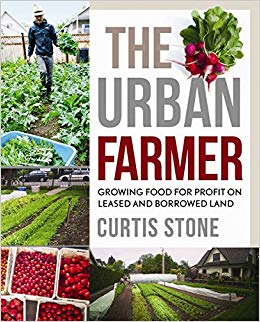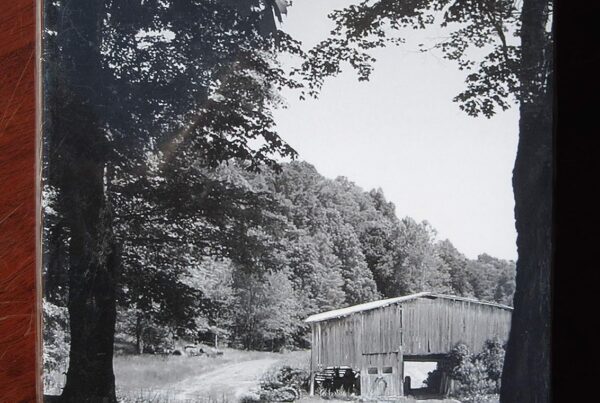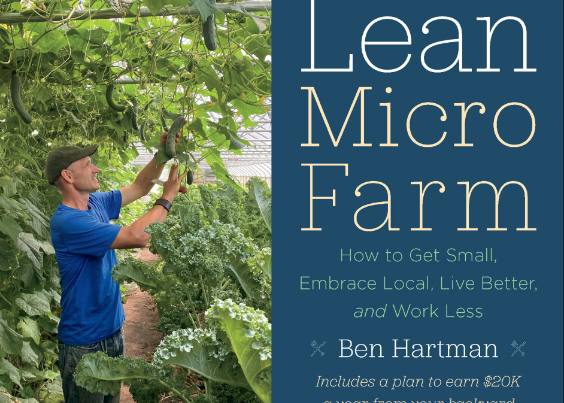
Curtis Stone
New Society Publishers, 2016
The Urban Farmer is part of the movement to make a good living as a farmer on a small area of land, without big machinery, as exemplified by Eliot Coleman, Jean-Martin Fortier and Ben Hartman (and as Colin McCrate and Brad Halm do for home gardeners). Curtis Stone supplies fairly high-end restaurants with leafy greens and a few other carefully chosen crops which bring a fast return. He also sells at a farmers market once a week. Curtis has figured out how to make the best use of small plots of urban land, and in the same way, he has figured out how to make best use of his time, so that he can earn a good 5-figure income from his one-third acre farm. He pays exquisite attention to what works and what doesn’t. Oh, and most of his transportation is by (electrically assisted) bicycle.
Curtis wrote this valuable book after only about 6 years as owner/operator of Green City Acres, a small commercial vegetable farm in Kelowna, British Columbia, Canada. He writes as an independently-minded entrepreneur engaged in sustainable agriculture, in being part of a better future, supplying very fresh produce to city-dwellers. He shows how would-be farmers with no capital, no land and no truck can get a start. This book will quickly earn its keep. If Curtis Stone is speaking at an event near you, be sure to go to it!
This is a very well-organized and well-written book. The language is clear and straight-forward. The short sentences are made for high-lighting! No skirting of sub-clauses is required. The 41 chapters divide into ten sections. Some chapters are very short. Curtis is not going to waste time filling blank space when he can explain the important stuff in a paragraph. He covers the why and where, and the business aspects, then finding and developing various plots of land into a cohesive small farm. He advises on infrastructure, equipment, production, harvest and post-harvest systems. He also covers basic crop planning.
This isn’t a book about growing a complete diet, or supplying a full range of vegetables for a CSA. Nor is it about how to grow carrots. There are 25 pages devoted to cameos of twenty recommended crops, but if you are a new grower, you’ll need more production info than you find here. Instead, this book can inspire and educate on how to make decisions likely to lead to successful sales, while focusing your hard work on the tasks that will get you there.
If you want to do multi-site urban farming to grow selected crops for restaurants in the Pacific North West or British Columbia in zone 7a, this book has most of what you need. But its usefulness isn’t at all confined to people in those regions, or to urban farmers, or to super-fit cyclists. So if your town already has a restaurant supplier of bio-intensively-grown salad crops and greens, do not despair. All vegetable growers can find something of value in this book, whether it is in his analysis of different crop types, growing microgreens, becoming more efficient, choosing good tools or keeping good records.
Curtis is a believer in farming smarter, not harder (but hard enough to make it all work). He puts the work in, in a timely way, is very observant, keeps good records, analyses his results and makes changes based on what his records show. He’s not one to grow red peppers “because everyone wants them.” If we follow our hearts only and ignore our sales figures and production costs, we won’t last long earning a living as farmers. Likewise, it’s good to have ethics and ideology, but if you go broke, you’ll be out of a job. If ten crops bring in 80% of the income, why not focus on those? After his first four years, Curtis reduced his farm from 2½ acres to 1/3 acre (5 plots close to each other). He cut his crop portfolio down to the most lucrative fifteen; he parted ways with his fellow worker, his CSA and most of his employees. His hours went down from 100 per week to 40 (and fewer of those were spent managing other people, more in planting and harvesting). His clients then were mostly restaurant chefs and his weekly farmers market. He had his best season that far, making a much higher dollar per hour.
Curtis is willing to change plans for a better idea, or to transform a crop failure or over-abundance into a baby beet greens opportunity. He sees the coming end of suburbia as a great opportunity to reclaim all those lawns for food growing: modern-day self-reliant farming communities. Being an urban farmer means interacting with lots of people every day, which leads to opportunities to educate about food, to be part of the local community, and to benefit from what local people will offer in terms of land, help and free advertising.
One aspect of the book I found particularly useful is the way Curtis divides crops and land into categories:
- Quick Crops (maturing in 60 days or less) mostly grown in Hi-Rotation plots: mostly salad greens and radishes. The Hi-Rotation beds might grow 4 crops in a single year, with no pre-planned crop rotation. Sometimes a Steady Crop like carrots is grown in a Hi-Rotation plot.
- Steady Crops (slower maturing, perhaps harvested continuously over a period of time): kale, tomatoes, carrots. These beds will be in a Bi-Rotation plot, which often will grow one Steady Crop as the Primary Crop, followed or preceded by a Quick Crop, especially one that can be cropped out at a single site visit, rather than requiring daily harvests.
It works best to have the Hi-Rotation plots nearest to the home base as they need the most frequent attention. Bi-Rotation plots can usually be further afield, except for indeterminate tomatoes which Curtis grows on a close spacing and prunes hard to improve airflow and encourage early ripening. Slow long season crops aren’t included, nor are ones that take a lot of space, like sweet corn.
The Crop Value Rating (CVR) is a useful way of comparing the advantages of various crops when choosing which to grow. Clearly this is important if space is limited. Less clear is the value of assessing crops this way when some other factor is limited. We do this when labor is limited. It clarifies stressful indecisive confusions. Here are the 5 factors Curtis assesses:
- Shorter days to maturity (fast crops = more chances to plant more)
- High yield per foot of row (best value from the space)
- High price per pound (other factors being equal, higher price = more income)
- Long harvest period (= more sales)
- Popularity (matched with low market saturation).
To use this assessment, give each potential crop a point for each factor where it deserves one. Then look for the crops with the highest number of points. Spinach gets all 5 points; cherry tomatoes only 3. The smaller your farm, the higher the crops need to score to get chosen.
Winter crops can be grown in hoophouses (polytunnels). Summer crops can help level the weekly sales out over the market season.
Various start-up models are spelled out, along with the caution to start small, say with ¼ acre, and low overhead expenses. Various market options are compared. The section on software and organization lists the ten spreadsheets Curtis prepares: Plantings, Yields, Crop Profiles, Weekly Orders, Weekly Sales Totals, Land Allocation Data, Budget and Expenses, Seed Order and Inventory, Plot Progress, and Spoilage.
There is a section on scouting for land and how to choose the best of your offers, and which to decline (heavy metal soil contamination, neighbors spraying herbicides, Field Bindweed, too much shade, too many rocks, owners needing too much caretaking. On the other hand, don’t be over nervous about invasive grasses, they can be conquered. There is information you won’t find in many other farming or gardening books, such as how to remove sod.
There is a thorough section on irrigation, set up for low management with timers and many sprinklers covering an area, or many lines of drip tape. I learned for the first time about flow through drip systems, where both ends of each drip tape are connected into the mains tubing, so that water can flow in both direction, and blockages will not be a problem. The costs are all spelled out (so get the book and buy the gear before prices go up!). Every section contains a gem that will save you time, money, mental strain or wasted crops. It hadn’t occurred to me that box fans could be laid flat above vegetable drying racks to dry washed greens and preserve the quality.
All of the equipment Curtis puts together is inexpensive and relatively easy to move to a new site. Two medium size coolers instead of one big one! Standard lengths of rowcover! Little decisions can have big benefits. Microgreens production indoors (in shallow flats) and outdoors (much less usual, but oh, the returns!) Curtis explains his special board technique for getting fast even germination.
The crops section focuses on providing the basic information through the perspective of factors already mentioned: Quick Crop or Steady Crop, months of harvest, Crop value rating, Days to maturity of recommended varieties, Yield per bed, Gross profit per bed, and also Planting Specs.
Here is a great book for those who want to make their farming time count and be as productive as possible, with best value for time and the land available.






